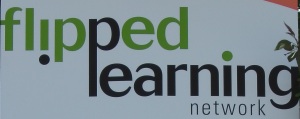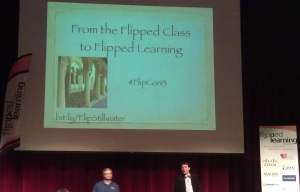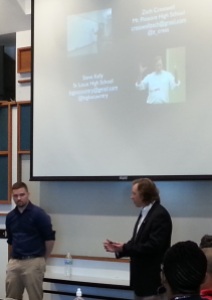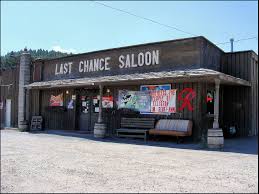 Greetings from Stillwater, Minnesota where Bea de los Arcos and I are at FlipCon13 – the annual conference for the Flipped Learning Network (FLN). The conference is being held at Stillwater Area High School. The Flipped Learning movement is growing at pace with over 500 physical attendees and 500 virtual attendees this year. There’s a lot of buzz and energy around flipping although a lot of the teachers we’ve spoken to have not necessarily thought about the open aspect of what they’re doing even when they’re publishing resources online. We’ve managed to spend some time with Kari Arfstrom, Aaron Sams, Jon Bergmann, Kristen Daniels, Julie Schen and Jerry Overmyer.
Greetings from Stillwater, Minnesota where Bea de los Arcos and I are at FlipCon13 – the annual conference for the Flipped Learning Network (FLN). The conference is being held at Stillwater Area High School. The Flipped Learning movement is growing at pace with over 500 physical attendees and 500 virtual attendees this year. There’s a lot of buzz and energy around flipping although a lot of the teachers we’ve spoken to have not necessarily thought about the open aspect of what they’re doing even when they’re publishing resources online. We’ve managed to spend some time with Kari Arfstrom, Aaron Sams, Jon Bergmann, Kristen Daniels, Julie Schen and Jerry Overmyer.
 We both attended the opening keynote by Aaron Sams and Jon Bergmann the founders of the Flipped Learning Network who presented their journey from traditional teaching to flipped mastery over the past 6 years. They also spoke on the Four Pillars of Flipped Learning, the key ingredients that are essential for flipped learning to take place. These have a neat acronym: FLIP (Flexible environment, Learning culture, Intentional content, Professional educator). Aaron and John spoke of the need to shift the learning culture from teacher-centred to student-centred, focussing on the relationship with learners rather than the content needing to be taught. They also spoke of the collaborative nature of their work.
We both attended the opening keynote by Aaron Sams and Jon Bergmann the founders of the Flipped Learning Network who presented their journey from traditional teaching to flipped mastery over the past 6 years. They also spoke on the Four Pillars of Flipped Learning, the key ingredients that are essential for flipped learning to take place. These have a neat acronym: FLIP (Flexible environment, Learning culture, Intentional content, Professional educator). Aaron and John spoke of the need to shift the learning culture from teacher-centred to student-centred, focussing on the relationship with learners rather than the content needing to be taught. They also spoke of the collaborative nature of their work.
The FLN has also been working with Pearson and George Mason University to provide a Literature Review of Flipped Learning (full report at flippedlearning.org). This session was presented by Kathy McKnight (Pearson) and Troy Faulkner (Flipped Learning teacher) who presented a case study of his own flipped class using peer instruction at Byron High School.
 Collaborative Flipping was also a strong theme throughout the conference and I attended a session presented by Zach Cresswell (@z_cresswell) and Steve Kelly (@bigkxcountry) who work collaboratively to make resources (mainly videos posted to UTube – Cress & Little) to teach Math which they publish online and are used in both classes. Steve was an advocate of sharing resources. Although the conference has focussed very much on how to flip your class and the technology behind that there were some good messages coming out regarding working collaboratively and sharing resources.
Collaborative Flipping was also a strong theme throughout the conference and I attended a session presented by Zach Cresswell (@z_cresswell) and Steve Kelly (@bigkxcountry) who work collaboratively to make resources (mainly videos posted to UTube – Cress & Little) to teach Math which they publish online and are used in both classes. Steve was an advocate of sharing resources. Although the conference has focussed very much on how to flip your class and the technology behind that there were some good messages coming out regarding working collaboratively and sharing resources.




Leave A Comment